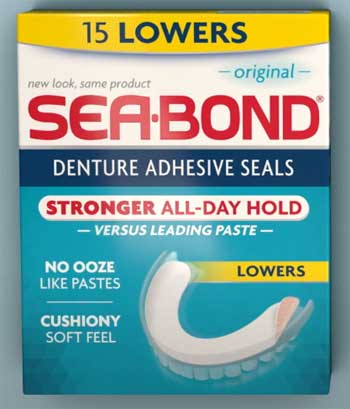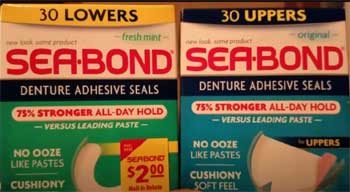If you’re like me, finding the right denture adhesive can feel like a never-ending quest. After trying countless products that left me frustrated and uncomfortable, I stumbled upon Sea-Bond denture adhesive.
This product promised a strong all-day hold without the mess and ooze typical of pastes and creams. Curious and somewhat skeptical, I decided to give it a try.
In this review, I’ll share my experience with Sea-Bond, comparing it to other popular adhesives, and provide some tips on how to get the best results. If you’re considering giving Sea-Bond a shot, I’ll also guide you on where you can easily purchase it.
My Experience With Sea-Bond Denture Adhesive
When I first opened the pack of Sea-Bond, I was struck by how different it was from other adhesives I’d tried. Instead of the usual paste or cream, Sea-Bond comes in the form of a thin, cushiony wafer.
The pack I purchased included 30 of these adhesive seals, which are designed for upper dentures. The promise of a zinc-free, mess-free experience was appealing, especially since I was tired of dealing with sticky residue in my mouth.
- The Initial Learning Curve

Using Sea-Bond for the first time wasn’t as straightforward as I’d hoped.
The instructions on the package seemed simple enough: moisten the wafer, place it in the denture, and insert it into your mouth.
However, I quickly discovered that getting the perfect fit required a bit of practice.
Initially, I struggled with trimming the wafer to the right size.
The first few times, I either trimmed too much or not enough, resulting in discomfort or a loose fit.
But after a few attempts, I developed a routine. I found that drying the dentures thoroughly before applying the wafer made a big difference.
The pink side of the wafer should be lightly moistened and placed down on the denture, making sure there are no bubbles. I also learned that trimming only the length, not the sides, gave me a better fit.
The wafer’s cushiony feel was immediately noticeable, providing relief from the discomfort I had experienced with other adhesives.
- The Hold and Comfort
Once I mastered the application, I was impressed with the hold. The adhesive kept my dentures in place all day without the need for reapplication. I could eat, drink, and even yawn without worrying about my dentures shifting.
However, I did notice that the wear time varied depending on what I ate. For example, after eating something particularly sticky, I sometimes felt the need to replace the wafer. Despite this, the overall comfort and lack of mess were significant improvements over other products I’d used.
One thing I particularly appreciated about Sea-Bond was the lack of ooze. With other adhesives, I often found myself dealing with unpleasant residue that would seep out around the edges of my dentures.
Sea-Bond eliminated this issue entirely, leaving my mouth feeling clean and fresh.
Pros of Sea-Bond Denture Adhesive

- Mess-Free Application: Unlike traditional denture adhesives, Sea-Bond doesn’t leave a sticky residue. The wafer format is clean and easy to use.
- Comfortable Cushion: The cushiony feel of the wafer adds an extra layer of comfort, which is particularly noticeable if your dentures don’t fit perfectly.
- Strong All-Day Hold: Once applied correctly, Sea-Bond provides a reliable hold that lasts throughout the day, even during meals.
- Zinc-Free Formula: For those concerned about the potential health risks associated with zinc in denture adhesives, Sea-Bond offers peace of mind with its zinc-free formula.
- Easy to Trim: Although it takes a little practice, trimming the wafer to fit your dentures is straightforward and allows for a customized fit.
Cons of Sea-Bond Denture Adhesive
- Learning Curve: It might take a few tries to get the application just right. The instructions provided are a good starting point, but personal adjustment is necessary.
- Wear Time Variability: Depending on what you eat, you may need to replace the wafer sooner than expected. Sticky or particularly chewy foods can reduce the adhesive’s effectiveness.
- Flavor: While Sea-Bond is available in an original flavor, some users might not prefer the taste. I found it subtle, but if you’re sensitive to flavors, it’s something to consider.
- Not Ideal for Immediate Use: If you’re looking for a quick and effortless adhesive, Sea-Bond may require more effort initially than you’re willing to invest.
Tips For Sea-Bond Denture Adhesive
To get the best out of Sea-Bond, a little maintenance and care go a long way. Here are some tips I’ve picked up along the way:
- Pre-Trimming: If you’re like me and prefer convenience, consider trimming all the wafers in the pack as soon as you open it. This way, you don’t have to go through the process every morning.
- Proper Denture Care: Make sure your dentures are completely dry before applying the wafer. This helps the adhesive stick better and ensures a more secure fit.
- Adjusting for Fit: If you notice the wafer slipping or not holding as expected, experiment with the amount of moisture you use. Sometimes, less is more when it comes to activating the adhesive.
- Replacement Timing: While Sea-Bond can hold all day, if you’re planning to eat something particularly challenging, consider having a replacement wafer handy. It’s easy to carry a pre-cut wafer with you and replace it when needed.
Comparing Sea-Bond With Other Denture Adhesives
Having tried several other brands before settling on Sea-Bond, I feel equipped to offer a comparison. Here’s how Sea-Bond stacks up against some of the most popular options:
- Sea-Bond Vs. Fixodent

Fixodent is perhaps one of the most well-known denture adhesives on the market. It’s a paste, which means it’s prone to the ooze that many of us find unpleasant.
In terms of hold, Fixodent does a good job, but I found the cleanup to be a hassle. The sticky residue left behind was challenging to remove from both my dentures and my mouth.
In contrast, Sea-Bond offers a mess-free experience. While it may require a bit more effort initially to get the fit right, the comfort and cleanliness make it worth it. If you’re sensitive to zinc, Sea-Bond’s zinc-free formula is another advantage over Fixodent.
- Sea-Bond Vs. Poligrip
Poligrip is another popular adhesive, known for its strong hold. Like Fixodent, it’s a paste and comes with the same issues of ooze and residue.
I’ve used Poligrip in situations where I needed a strong hold for extended periods, such as social gatherings or long outings. It performed well, but I always dreaded the cleanup afterward.
Sea-Bond, while perhaps not as instantly strong as Poligrip, provides a more comfortable and cleaner experience. The cushiony feel of Sea-Bond is something Poligrip can’t match.
However, if you need an ultra-strong hold and don’t mind the mess, Poligrip might be the better option for those specific occasions.
- Sea-Bond Vs. Cushion Grip

Cushion Grip is different from both Sea-Bond and the other adhesives mentioned in that it’s a thermoplastic polymer. It provides a secure hold that can last for days, but it’s more involved to apply.
The process includes heating the product and molding it to your denture, which can be time-consuming.
While Cushion Grip offers a long-lasting hold, it’s not as convenient for everyday use. Sea-Bond, on the other hand, is quick to apply once you’ve got the hang of it. If you’re looking for something easy to use daily, Sea-Bond is more practical.
Cushion Grip might be better suited for those who want a more permanent solution without daily application.
Frequently Asked Questions (FAQ)
In many ways, yes, especially if you value comfort and cleanliness. Sea-Bond doesn’t ooze like Fixodent, making it a cleaner option. It also provides a cushiony feel that enhances comfort, which is particularly beneficial if your dentures aren’t a perfect fit. However, Fixodent might offer a slightly stronger hold right off the bat, which could be important in certain situations.
Sea-Bond is a solid choice for those who want a clean, comfortable, and effective adhesive. It’s particularly good for users who dislike the mess associated with paste adhesives. While it does require a bit of practice to get the fit right, the end result is worth it for the comfort and all-day hold.
The “best” adhesive depends on your specific needs. If you’re looking for the strongest hold, products like Poligrip or Fixodent might be better in situations where you need maximum security. However, if you prioritize comfort and cleanliness, Sea-Bond is a fantastic option. Cushion Grip offers a long-lasting hold, but it’s more involved to apply.
Sea-Bond works by using a thin, cushiony wafer that adheres to your denture and gums when moistened. The adhesive activates upon contact with moisture, forming a gel that holds the denture in place. The wafer also provides a cushion, making the denture more comfortable to wear throughout the day.
Wrapping Up
After using Sea-Bond denture adhesive for several months, I can confidently say it’s one of the best options out there for those looking for a clean, comfortable, and effective solution.
While it requires a bit of a learning curve, the benefits far outweigh the initial effort. The mess-free application, strong hold, and cushiony feel make Sea-Bond a standout choice for anyone who wears dentures.
If you’re tired of dealing with the sticky residue and discomfort of paste adhesives, I highly recommend giving Sea-Bond a try. You can easily find it at major retailers or online.
Once you get the hang of applying it, you’ll likely find, as I did, that it’s a game-changer in your daily routine.

I’m just not positive how much to moisturize the pad. And does it matter if I used warm or cold water?